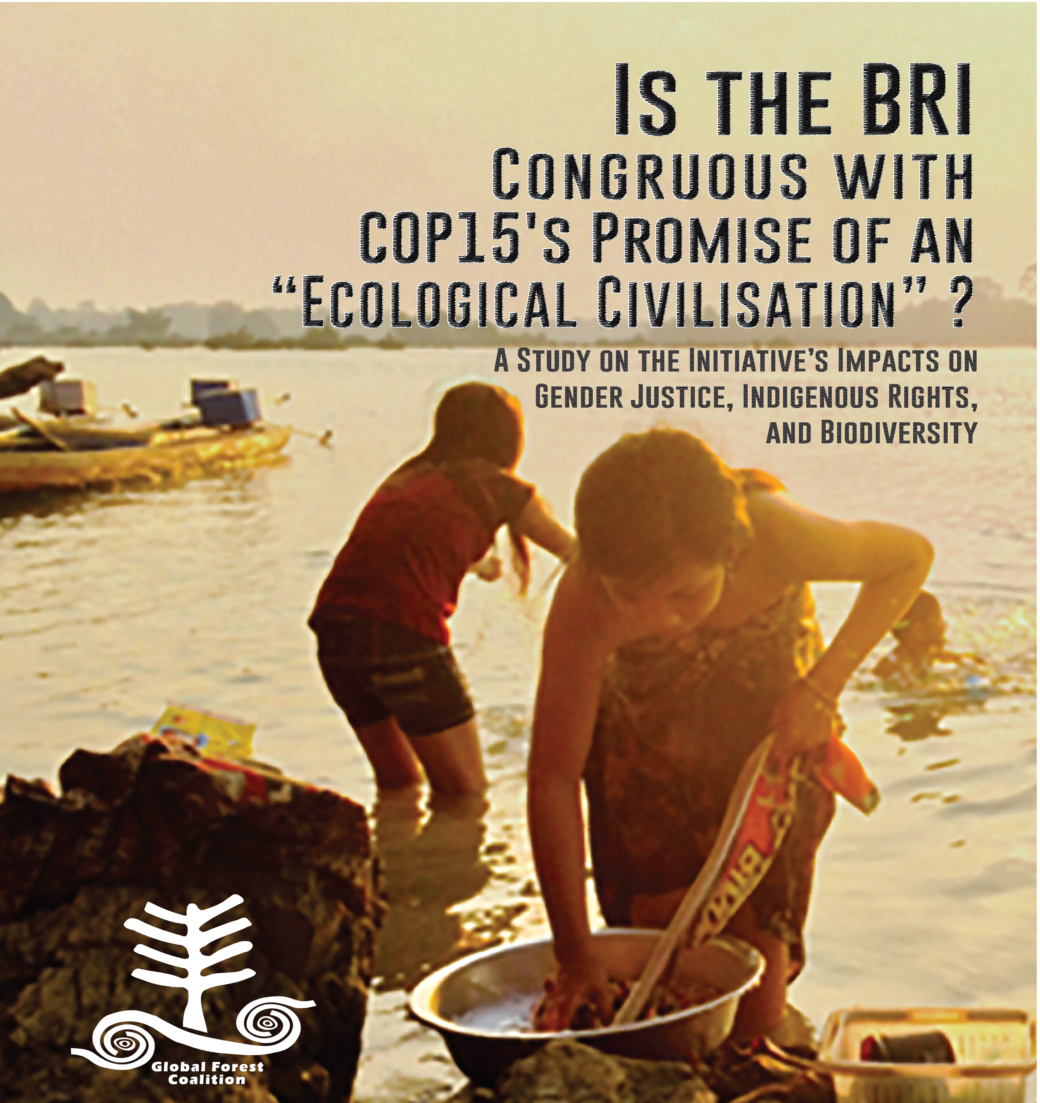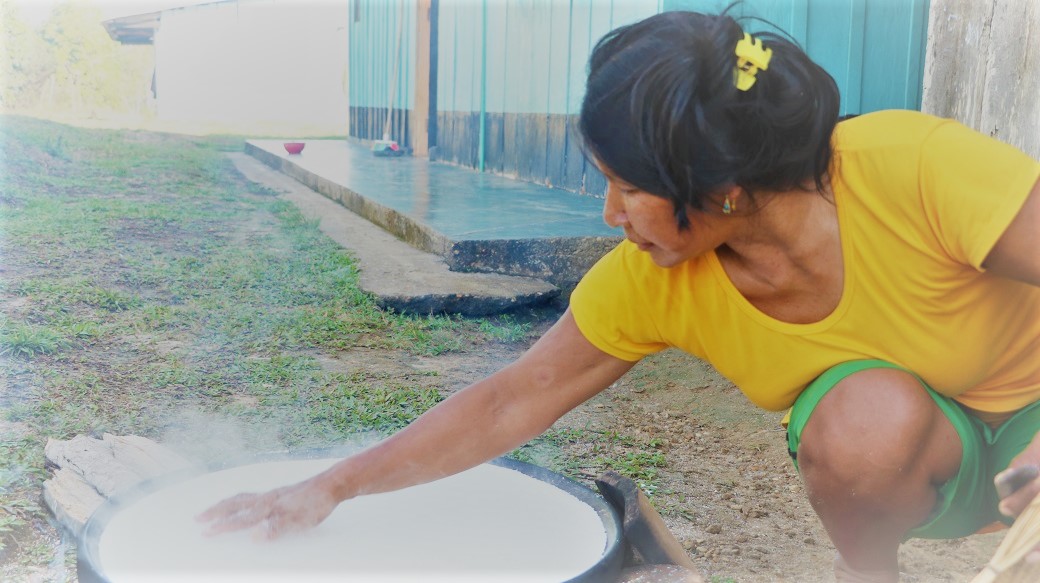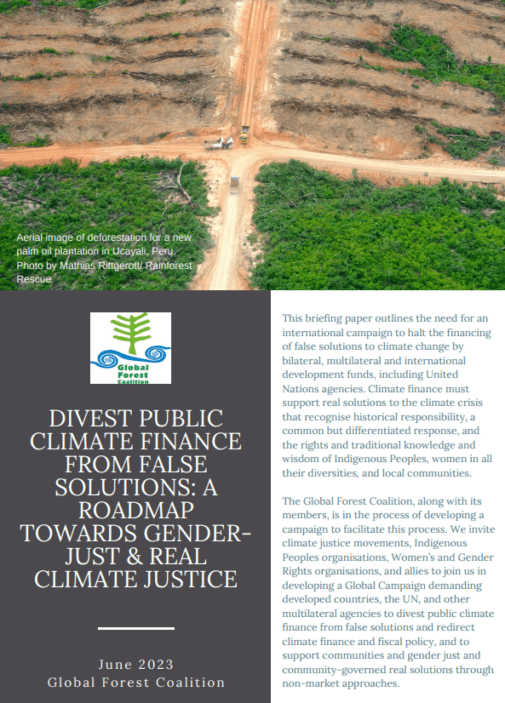Briefing: Is the BRI Congruous with COP15’s Promise of an “Ecological Civilisation”?

As the parties to the UN Convention on Biodiversity (CBD) meet in Montreal, we’re looking at the need for real solutions to biodiversity loss and the big processes and factors that would seem to undermine the stated goals of the CBD.
The Belt and Road Initiative is a massive infrastructure program that would have deep impacts on forests and other ecosystems on all continents, and specifically on Indigenous and local communities throughout Asia, Africa and Latin America.
What does this global infrastructure project mean for the so-called “ecological civilisation” that leaders are seeking to advance at the 15th Conference of the Parties to the CBD? What does it mean for women, who bear the greatest share of the burden of care work that sustains life on the planet and the capitalist system?
These questions are addressed in our new study on the BRI’s impacts on gender justice, Indigenous rights, and biodiversity.
Is the BRI Congruous with COP15’s Promise of an “Ecological Civilisation?
A Study on the Initiative’s Impacts on Gender Justice, Indigenous Rights, and Biodiversity
By Allie Constantine
China’s Belt and Road Initiative (BRI) is an astonishingly ambitious plan to construct roads, railways, ports, and more recently health, digital, and space projects, building physical and economic links between Asia and much of the world, enhancing trade and interconnectivity. The BRI is not a single Chinese government initiative, but rather consists of many different projects financed through multiple avenues including Chinese and international banks and investment funds.
Hailed by President Xi Jinping as a strategy to “build a new platform for international co-operation to create new drivers of shared development,” the BRI is, however, not without its controversies and serious environmental and human rights concerns—including impacts on biodiversity, gender, and Indigenous rights—have been raised in many of the countries where BRI projects are being undertaken. Since COVID-19, China has halted many BRI projects, also raising new questions about globalisation and localisation. In 2019, the Global Forest Coalition delved into specific aspects of different BRI systems in the Forest Cover #60 report: “How is the Belt and Road Initiative (BRI) impacting women and forests?” Building upon previous research, this paper assesses how BRI processes have evolved by looking at differential impacts on gender, forests, and rural and Indigenous communities, as well as the interconnected forest and biodiversity impacts.
As the 15th Conference of the Parties of the Convention on Biodiversity (CBD COP15) gets underway in Montreal, Canada under a Chinese presidency, this analysis seeks to bring attention to the imperative of divestment from harmful activities under the BRI and the urgent need to include gender analysis and the perspectives and voices of Indigenous Peoples and directly impacted communities on the ground.
Gendered Impacts of BRI
Before COVID-19, analyses of the gendered impacts of BRI projects were lacking. Since then, there is still no impact assessment on how the BRI affects women, and China has not released data on gender and the BRI. Given that China has signed and ratified most UN human rights treaties including the Convention on the Elimination of all Forms of Discrimination against Women (CEDAW) and the United Nations Sustainable Development Goals (Goal 5 being “Gender Equality”), China is obliged to report on gender impacts of BRI projects it operates. According to one report, since the BRI’s inception, most of those who have benefited financially are men. The lack of gender data is relevant elsewhere, as China has also not addressed its gender gap and women are underrepresented in leadership positions regarding climate change. While China’s 14th Five-Year Plan discusses women’s equality and gender rights, there is no indication of how China will implement or enforce this within the BRI, if at all.
Even without this data, we can still make certain inferences regarding gendered impacts. GFC’s report from 2019 as well as a recent report on deforestation-free commodities examine how the commodity trade, which is often dominated by men, not only impacts forests but also negatively impacts women disproportionately. This trade eventually replaces important small-scale and locally oriented production that is often led by women. When trade expands into new territories, women frequently earn less, have fewer opportunities to acquire valuable skills, and often become increasingly economically dependent on men. Ultimately, men gain more economic and decision-making power. As further highlighted in the 2019 report, simply giving more BRI jobs to women does not ameliorate these deeply unequal gender impacts.
BRI projects that continue to prioritise commodity-based global trade as it exists now necessarily continue to harm women and gender-diverse people. Historical precedence also shows us that women and gender-diverse people are more susceptible to environmental harm, gendered violence, and economic disparity caused by trade development and extractivism. Given that forest, rural, and Indigenous communities are at higher risks for gendered violence in general, BRI gender analysis that takes these intersections into account is imperative.
Impacts on Forest Communities
Indigenous and forest communities are also often negatively affected by specific BRI projects. For example, the Indigenous Mah Meri community in Malaysia is frequently harmed by government processes, including the development of BRI ports in Mah Meri territories. Malaysia supposedly supports the United Nations Declaration on the Rights of Indigenous Peoples (UNDRIP), and yet frequently acts against Indigenous land rights and human rights. Some community members also indicated that they perceive the creation of BRI ports as Malaysian state-specific land-grabbing and neo-imperialism rather than simply Chinese neocolonialism. With the backing of Chinese investments, it would seem states may continue to disenfranchise their populations and encroach on Indigenous territories through BRI projects.
For Indigenous rights in general, there is a lack of consideration for adequate consultation with Indigenous and on-the-ground perspectives. This report in collaboration with the Mah Meri community found that the consistent exclusion of Indigenous discourses and consideration within mainstream BRI literature reflects the general exclusion of Indigenous perspectives more broadly. BRI projects frequently do not examine impacts on Indigenous people, nor do they include their perspectives. In practice, neither the Chinese government nor Chinese businesses or banks are required (or even encouraged) to provide consultation with communities on the ground. Completely omitting Indigenous perspectives is not only harmful to communities and biodiversity but also a violation of human dignity.
A separate report in 2019 shed light on a wide array of human rights abuses in Cambodia due to BRI expansion. This report demonstrated how during the implementation and construction of the Lower Sesan 2 Dam in Cambodia (jointly funded by the China Huaneng Group, the Royal Group Cambodia, and the state-owned Vietnam Electricity), the Chinese government had not taken steps to ensure that the companies involved conducted or disclosed any meaningful social and environmental impact assessments. Further, project developers did not deem community consultation necessary in the planning and construction processes. Consultation and adequate protections are vital for communities impacted by BRI projects, especially those already facing threats. Cambodian land and environmental defenders, especially those from forest communities, are routinely threatened with violence. One report documented over 1000 deaths since 2002, and women are the most at risk. Many Cambodians still protest the dam and indicate that the environmental hazards are still very pressing.
The construction of dams also routinely intersects with forests and forest communities and Indigenous people in Indonesia are severely impacted by BRI projects in multiple ways. Hydropower plants are often placed nearby primary forests, and three plants in Indonesia specifically threaten local Indigenous communities with displacement due to flooding. They also threaten rare and endangered animals such as the Tapanuli orangutan and other keystone species. In particular, the Batang Toru rainforest is at risk due to the construction of a dam, which is said to have already had “devastating effects on biodiversity.” Due to the deforestation caused by the dam, flooding has also become a risk. Forest-dependent people who live within these areas have faced flooding of their farmlands, loss of river agriculture and other livelihoods tied to the river, and forced displacement from their ancestral homes. The World Bank and the Asian Development Bank refused to fund the dam due to these concerns. Yet in 2019, North Sumatran courts decided construction would continue, and the project is currently being financed by Chinese company SDIC Power. The Bank of China was also planning to fund the project, but environmental and human rights concerns led it to announce it was going to “evaluate the project very carefully.” Since this statement in 2019, no new information has been released and the funding of the hydropower project is shrouded in mystery. All signs point to its continuation which will undoubtedly have incredibly detrimental effects on biodiversity and human rights.
While China has signed and ratified the majority of human rights treaties, including CEDAW, ICCPR, CERD, and CESCR, as well as voted in support of UNDRIP, it is unclear how seriously the rights of Indigenous People are taken within the BRI. The lack of any enforcement or encouragement of consultation with communities on the ground exemplified through the Indigenous and forest communities mentioned above indicates that Indigenous inclusion may not be prioritised.
Greening or Greenwashing?
In December 2019, another report indicated how some of China’s BRI projects negatively impact the environment, especially in Southeast Asia. The BRI’s expansion through important ecological corridors, including Chinese-backed hydropower projects built along the Mekong River that cause changes in river flow, directly puts specific communities and fragile ecosystems at risk. In turn, this impacts fish migrations and creates a further loss of livelihoods for downstream communities in Laos, Cambodia, Thailand and Vietnam that rely on the river for sustenance. The same report examined how deforestation due to the expansion of the BRI Pan Borneo Highway spanning Malaysia, Indonesia, and Brunei, set to be complete in 2028, has caused major deforestation, contributing to increasing landslides and floods. Additionally, the World Wildlife Fund examined how BRI projects will affect 1,700 biodiversity hotspots, threaten 265 species, and potentially introduce hundreds of alien species that threaten these fragile ecosystems.
On the other hand, since COVID-19 began, China has been intensifying “Green BRI” efforts, including research on how to make BRI projects more environmentally sound. For example, in 2021, the Chinese Ministry of Foreign Commerce and the Ministry of Ecology and Environment released “Green Development Guidelines.” China has also committed to ending coal-fired power plants and investing in renewable energy sources. However, as seen previously through dam projects along the Mekong, hydropower dams also threaten biodiversity, forests, and forest communities—simply defunding coal and investing in other potentially harmful projects is not the solution.
Further, while these “green” initiatives offer guidance, “they are neither binding nor specific enough to be implementable.” According to one investigation, the “Green BRI” explicitly mentions biodiversity multiple times, however, there are no measures to ensure its protection, and there are no sanctions for breaches. The research found that BRI land projects, including more recent upgrades, bypass twenty-one protected areas in mainland Southeast Asia, putting protected biodiverse areas at risk. New railways are often constructed in natural and protected spaces, increasing the likelihood of detrimental effects caused by noise pollution, accidents, and poaching, while the destruction of habitats still occurs, putting wildlife and forest communities at heightened risk.
China is also one of the biggest importers of industrially-produced beef and soy, commodities that are of particular concern for the environment. The increase in globalised trade through BRI as well as the reliance on imported beef and soy contradicts China’s commitment to decreasing coal production as global trade is one of the biggest sources of greenhouse gas emissions. This contradiction raises the question of whether China is simply exporting problematic industries to other places, much like “western” countries do.
The “greening” of the BRI is thus contentious, and it is difficult to see exactly how it is becoming more environmentally friendly. More research and further transparency are needed. A BRI that promotes the business-as-usual, export-oriented development model will harm the climate and economically marginalised groups like Indigenous Peoples, peasant communities and women who cannot compete with it. While solutions posited, such as the creation of ecological corridors, biodiversity monitoring stations, and more may allow for better impact evaluation, and increasing funding for BRI projects to focus on ecological infrastructure could help mitigate climate impacts, China must implement this alongside a more transformative approach to global trade and consumption. Given that the BRI affects most of the world, and China is presently one of the biggest global carbon polluters, it has the unique ability to alter the international emissions contributing to the global catastrophe. Importantly, protecting current biodiversity, forests, and forest communities is more impactful than investing or implementing shiny new solutions, especially since forest communities are currently facing forced displacement and the worst of climate disasters.
We must also be reminded that a “green” BRI does not necessarily mean a socially equitable and gender-just BRI. Women, gender-diverse people, and Indigenous communities may still be subject to the negative consequences of “green” BRI projects. Therefore, a gender analysis and the enthusiastic inclusion of women and gender-diverse people, and especially Indigenous perspectives, discourses, and impacts are imperative going forward.
The Future of the BRI
Since 2019, there has been a lack of clarity regarding changes to the more harmful BRI projects. The 2019 GFC report exposed multiple problems such as overestimating the host countries’ capacity to enforce safeguards, lack of addressing governance challenges and policy incoherence, as well as a lack of participation in social movements representing Indigenous People and forest communities and women. It would seem that this is still the case as the lack of transparency and dialogue persists. Since the pandemic, China has also abandoned many BRI projects and other planned projects could yet face a similar outcome. While abandoning harmful projects before they begin mitigates some of the harm that could occur during implementation, this also highlights the shaky nature of some of the project’s finances and overly ambitious plans, and the need for overall divestment from harmful activities before projects get underway.
China is not the only major player concerning BRI development, and it would be incomplete to solely implicate it in its negative aspects. For example, Germany is a staunch supporter of the BRI, as are many European, Asian, and African countries. Not all projects are seen as negative, either. Some countries that have historically been disadvantaged through unequal and unjust development and colonisation are seemingly happy with some of the BRI’s “green” projects. However, many Indigenous and rural communities who are directly impacted by certain projects are voicing their concerns, and they should not only be listened to but also adequately consulted with proper space being given to women and gender-diverse people.
Indigenous Peoples globally have unique and valuable cultures and lifeways deserving of thriving. We must consistently remind global leaders that Indigenous Peoples also steward the majority of the world’s biodiversity, ensuring the survival of life on Earth. If this is not considered imperative in BRI expansion, it would seem that many of the ongoing and future projects follow the same damaging extractivist logic that is incompatible with climate justice and human rights. At the 2021 CBD COP, Indigenous communities in China were invited by the state to participate, which hopefully indicates that change will come. The 15th CBD COP in Montreal needs to not only include, but prioritise, the concerns and Indigenous perspectives if it is to be in any way successful.
Going forward, especially on the heels of COP15, divestment from all harmful BRI projects is necessary if we are to make any progress in the protection of biodiversity and human rights. The summit has already been downgraded to an ordinary conference and heads of state are not attending. Many observers argue the COP15 goals are not ambitious enough for the change that is required. While China and other major players keep discussing their commitment to “green” development, it remains to be seen how this is being prioritised. China discussed its aim to promote “ecological civilization,” stating the commitment to “building a shared future for all life on Earth.” Given the continued harmful impacts of certain BRI projects, we must ask: whose lives count to world leaders, and how is the BRI coherent with the goal of a so-called ecological civilization? The track record of human rights abuses, lack of meaningful consultation and inclusion of women and Indigenous People in all of their diversity, and continued destruction of wildlife and biodiversity leaves many questions unanswered that we hope will be addressed going forward.








